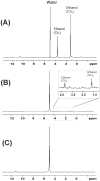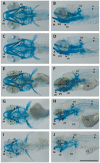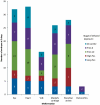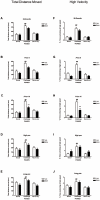Large-scale analysis of acute ethanol exposure in zebrafish development: a critical time window and resilience
- PMID: 21625530
- PMCID: PMC3098763
- DOI: 10.1371/journal.pone.0020037
Large-scale analysis of acute ethanol exposure in zebrafish development: a critical time window and resilience
Abstract
Background: In humans, ethanol exposure during pregnancy causes a spectrum of developmental defects (fetal alcohol syndrome or FAS). Individuals vary in phenotypic expression. Zebrafish embryos develop FAS-like features after ethanol exposure. In this study, we ask whether stage-specific effects of ethanol can be identified in the zebrafish, and if so, whether they allow the pinpointing of sensitive developmental mechanisms. We have therefore conducted the first large-scale (>1500 embryos) analysis of acute, stage-specific drug effects on zebrafish development, with a large panel of readouts.
Methodology/principal findings: Zebrafish embryos were raised in 96-well plates. Range-finding indicated that 10% ethanol for 1 h was suitable for an acute exposure regime. High-resolution magic-angle spinning proton magnetic resonance spectroscopy showed that this produced a transient pulse of 0.86% concentration of ethanol in the embryo within the chorion. Survivors at 5 days postfertilisation were analysed. Phenotypes ranged from normal (resilient) to severely malformed. Ethanol exposure at early stages caused high mortality (≥88%). At later stages of exposure, mortality declined and malformations developed. Pharyngeal arch hypoplasia and behavioral impairment were most common after prim-6 and prim-16 exposure. By contrast, microphthalmia and growth retardation were stage-independent.
Conclusions: Our findings show that some ethanol effects are strongly stage-dependent. The phenotypes mimic key aspects of FAS including craniofacial abnormality, microphthalmia, growth retardation and behavioral impairment. We also identify a critical time window (prim-6 and prim-16) for ethanol sensitivity. Finally, our identification of a wide phenotypic spectrum is reminiscent of human FAS, and may provide a useful model for studying disease resilience.
Conflict of interest statement
Figures










References
-
- Harwood HJ, Fountain D, Fountain G. Economic cost of alcohol and drug abuse in the United States, 1992: a report. Addiction. 1999;94:631–635. - PubMed
-
- Wattendorf DJ, Muenke M. Fetal alcohol spectrum disorders. Am Fam Physician. 2005;72:279–82, 285. - PubMed
-
- Chudley AE, Kilgour AR, Cranston M, Edwards M. Challenges of diagnosis in fetal alcohol syndrome and fetal alcohol spectrum disorder in the adult. Am J Med Genet C Semin Med Genet. 2007;145C:261–272. - PubMed
-
- Spohr HL, Willms J, Steinhausen HC. Fetal alcohol spectrum disorders in young adulthood. J Pediatr. 2007;150:175–9, 179. - PubMed
-
- Moore ES, Ward RE, Wetherill LF, Rogers JL, utti-Ramo I, et al. Unique facial features distinguish fetal alcohol syndrome patients and controls in diverse ethnic populations. Alcohol Clin Exp Res. 2007;31:1707–1713. - PubMed
Publication types
MeSH terms
Substances
LinkOut - more resources
Full Text Sources
Molecular Biology Databases
Research Materials
Miscellaneous

